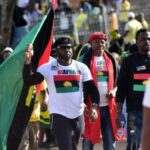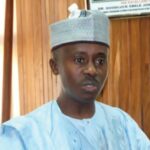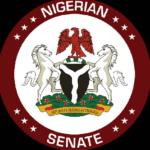The governor split the kingdom into three, dethroning the Nunku people in the process. The three chiefdoms are Nunku, Nghah and Mada. While the Nunku people whose traditional headquarters is Andaha from where they ruled over the vast kingdom have lost by the governor’s intervention, the Mada people have now claimed it. The split now leaves the Nunkus with only a district known as Nunku district, while Nghah chiefdom’s territorial jurisdiction shall include Gudi, Rinze, Anjida and Agyaga districts. The Mada Chifdom has territorial jurisdiction over Ningha’an, Ancho, Ningo/Bohar, Gwanje, Akwanga, headquarters of Akwanga Local Government Area, and Andaha districts.
Nasarawa community goes 35 years without ruler
This decision was conveyed in a statement signed by the Secretary to the State Government, Timothy Anjide, on June 14. It said the decision was meant to promote inter-communal harmony, social cohesion and orderly grassroots administration, adding that it will “amicably resolve the protracted dispute over the Mada Chieftaincy Institution.” It said the decision was taken after due consultation with the council of chiefs and in accordance with Section 54 of the state Local Government Law 2009 which approves the reconstitution of the old Mada Chieftaincy under the Appointment of Chief of Mada Order 1977 into three new chiefdoms.
The decision has been hailed by the majority Mada people as wise intervention in the decades of tussle over the rulership of the kingdom. But the decision received a swift response from the Nunku people who want the status quo maintained as contained in the subsisting court judgments which upheld the Nzoja family of the people as the exclusive rulers of the entire kingdom of Mada. They are insisting the government did not consult with them, and so cannot claim to have been interested in resolution of the three decades of dispute in the kingdom. Signed by, Alhaji Yakubu Yusuf Pakachin Nunku, a statement rejected the decision as acting in gross violation of the court judgments and the Rule of Law.
The Pakachin Nunku also queried the governor for buying his way into the heart of the majority Mada clan to lay good foundation for his re-election bid in 2011. “But we are not working against the re-election bid of His Excellency, Governor Aliyu Akwe Doma. We the Nunku people are his ardent supporters and we have remained loyal to him. We are all of the Peopple’s Democratic Party (PDP),’’ said Alhaji Yusuf.
Weekly Trust recalls the chain of events which developed into the over three decades of stalemate, legal tussles, politicking and the general crisis in the emergence of Chun Mada. It began with the death of Alhaji Musa Abdullahi, the last ruler from the Nzoja royal family in 1976. The Madas started to agitate for the democratization of the stool to pave the way for any male of the kingdom to be selected Chun Mada instead of maintaining the status quo which restricted the stool to only the Nzojas of the Nunku clan. The agitation stalled the selection of a successor to Musa Abdullahi, compelling the then Plateau State government to set up a panel headed by the Grand Khadi of Benue and Plateau states, Alhaji Yahaya Kanam, which recommendation favoured the Nzojas: that the family has established a traditional ruling house and that eligibility to the stool be restricted to the adult male descendants of that family and that the existing college of electors be retained. The state government then went ahead to appoint the Madakin Nunku, Abdullahi Tukura, from the Nzojas, as an administrator to succeed Musa Abdullahi in 1976.
But the Mada elites dug in their feet, insisting otherwise, and compelling the government to set up another committee headed by one Ahmadu Tanko, which recommendation favoured them. Apart from recommending the democratization of the stool, this committee sought to raise the number of selectors from the original four to 21. Government obliged, and in the interim, appointed an administrator – Halilu Bala to oversee the chiefdom from 1977 to 1978.
The royal house stood vehemently against the committee’s recommendation and in October 1978, the government handed the tussle to a representative committee of traditional rulers in the state. This committee recommended against the democratisation of the chieftaincy and advised government to acknowledge and recognise the supremacy of the Nzoja dynasty and that succession to the throne of Mada chiefdom be made available to the male descendants of the Nzoja royal family.
The committee recommended, among other measures, the creation of more districts in the chiefdom, the removal of the administrator to pave way for “an orderly selection of Chun Mada”, hoping that “the desire of Mada people to be fully represented in matters of chieftaincy be realised for the good of all.” But this was not to be as no orderly selection was achieved in the long run as a new government, this time by Solomon Lar of the Nigerian People’s Party (NPP), sat tight on the recommendations, and rather abolished the Nzoja dynasty’s exclusive claim to the throne following the recommendations of a new committee the new administration set up in 1980.
The Lar arrangement attracted several protests by the Nunkus, but all in vain, and as a result, a new Chun Mada, Illiya Rini emerged from the two legal notices. His short reign was tumultuous. His death in 1989 ignited a free for all quest to ascend the throne. Gamu Yare emerged from this contest. The Nzoja dynasty protested to the court in 1990 and won the case after about five years of legal tussle at the Jos High Court, with the judgment declaration that the Plateau State legal notices 2 and 3 of 1980 were null and void; that the appointment of Chief of Mada Order 2 of 1977 is still valid and binding on the appointment and selection of Chief of Mada; that the selection and appointment of Gamu Yare who was also the 1st defendant as Chun Mada was illegal and a gross violation of the native laws and custom concerning the Mada chieftaincy institution because he is not from Nzoja dynasty.
But while the trial was ongoing, the defendants rushed to another court in Keffi on the ground that the high court had no jurisdiction to entertain the case. The royal family then headed for the Supreme Court for interpretation of the contested jurisdiction and the apex court referred the case back to the high court in Jos in 1996, and judgment was in favour of the royal family. The only way to peace, the judgment read in part that Gamu Yare and his supporters must “be able to distinguish between a democratised institution like their local government council headed by their chairman of which everybody can aspire and an established traditional institution like the Mada chieftaincy institution.”
The defendants appealed at the Jos Appeal Court on July 18, 1996, but lost after close to five years of legal tussle as the Justice Ibrahim Tanko Muhammad ruling of January 20, 2000 affirmed the judgement of the lower court and dismissed the appeal in its entirety as lacking in merit. Yare headed for the Supreme Court, but had to withdraw the case midway after a peace meeting he said was held by the elders of the land. Pursuant to the notice of withdrawal by Yare, therefore, the Supreme Court on May 3, 2005 dismissed the appeal with no order as to cost.
In a term of settlement dated November 22, 2003, reference was made to the resolution by the entire Mada people that the judgement of the Plateau State High Court, upheld by the Appeal Court Jos should abort, abate and cease to apply to Mada chieftaincy institution; that having regard to historical antecedents, the entire Mada people resolved and agreed that the Mada chieftaincy institution with 1st class status is to be democratized and thrown open to every male adult including members of Nzoja family of the Nunku clan; that Mada people support the creation of additional chiefdoms in Nasarawa State, urging government to expedite action in that direction; and that four additional subordinate chieftaincy institution should be created each with 3rd class status in the land.
However, the Nunkus, led by the Nzojas, said they were never party to the resolution. In a letter to the then governor, Abdullahi Adamu on February 9, 2004 the Nzojas acknowledged there were six meetings to resolve the crisis; no resolution was reached, however. Titled: “Re:Mada chieftaincy dispute”, the letter raised reactions to the purported resolution, the dynasty said it is not against the demand by other linguistic groups for additional chiefdoms provided that the Nzojas retain the disputed Chun Mada stool as its exclusive right. The letter urged the governor to install a new Chun Mada by enforcing the various court judgements, while also creating additional chiefdoms to meet majority aspirations and assuage fears of domination.
The Mada people were said to have migrated into the area in small groups. Although the people did not seem originally to recognise a paramount chief, historical records show there existed among the people a form of association that was strengthened during invasions. Records also that among the Mada, clan heads and village chiefs existed as far back as 200 years or more – among them, Nunku which appeared to be more sophisticated and therefore became a ready channel of administration. Thus Nzoja dynasty of Nunku came to be recognised for the throne.
Nunku clan consists of four groups: Umazanwe, Umummuje, Ngwom and Nicho; each with its own leader. In 1800 the four groups decided to create Mada Chiefdom and Nzoja was elected as the first ruler. He ruled from 1800 to 1820, and was succeeded by Mwanda, his brother. Dnanwai, the son of Nzoja held fort from 1841 to 1866 after the demise of Mwanda and another son of Nzoja, Gbasanzu took over. And so the Nzoja linage hold fort until the demise of Alhaji Musa Abdullahi the last ruler from the royal family in 1976. The ruling family was said to have moved from their original base along the Nasarawa/Kaduna borders to the present location, Andaha in October 1932 on the directive of the colonial authority which insisted that the paramount ruler should move to the centre of the entire Mada people. The then ruler, Ahmadu Yamusa was said to have resisted this directive for fear that his people were going to be cut off from their farming, as predominantly farmers, but threats by the colonialists to set soldiers to destroy the area, finally compelled Yamusa into conceding. The dynasty first moved into a camp where it stayed for six months while the palace was been built. The Nzojas finally entered the palace on April 15, 1934.
Today, this palace stands desolate and abandoned at the densely populated town of Andaha, north of Akwanga. The once symbol of authority and unity of the great Mada people is now a mere habitat for stray goats and other livestock as well as rodents. The layers of cobweb and thick dust that chock the interior made peeing difficult for this reporter who visited earlier in the week. The final level of decay: rusty and leaking zinc sheets, the pale walls, overgrown weeds, pools of stagnant rain waters and other forms of deplorable condition have taken over the once centre of activity of the once vibrant kingdom until the death of the last ruler, Musa Abdullahi in 1976.
The last occupant, Gamu Yare, never functioned to attract subjects to the palace as the courts stopped his installation until he died last year. Now, the traditional palace is only a graveyard since it was finally sealed off after Yare’s death. It stands in Andaha as the physical symbol of the 35 years of chieftaincy tussle of a once united people of Mada Kingdom.
 Join Daily Trust WhatsApp Community For Quick Access To News and Happenings Around You.
Join Daily Trust WhatsApp Community For Quick Access To News and Happenings Around You.



